Welcome to our guide on using Rust-Oleum Farm and Implement Paint! This article provides essential instructions for preparing surfaces‚ applying primer‚ and painting farm equipment effectively. Learn how to achieve a durable‚ weather-resistant finish while avoiding common mistakes.
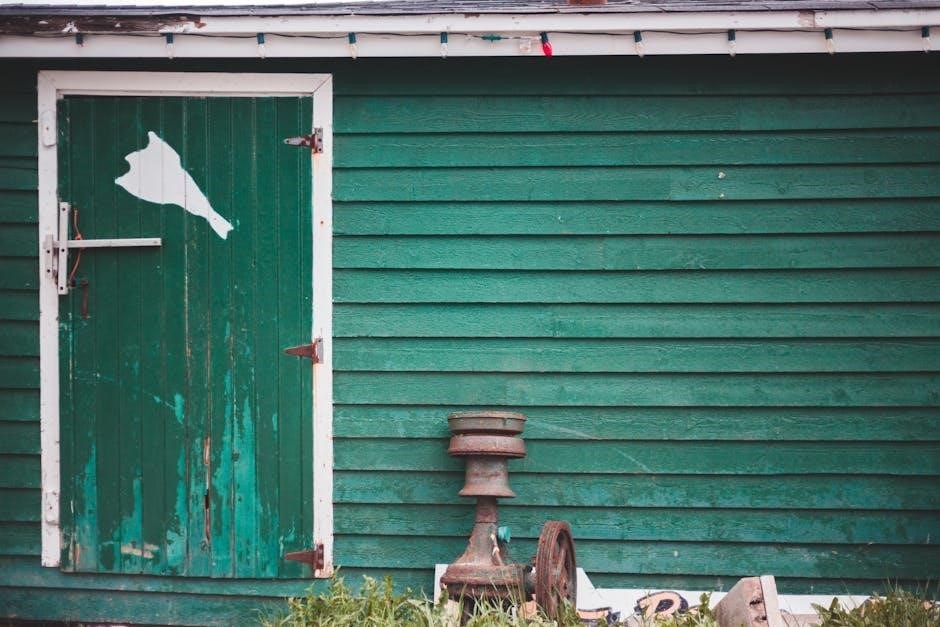
Surface Preparation
Surface preparation is crucial for a durable finish. Scrape and wire brush to remove rust and old coatings. Use Rust-Oleum Rusty Metal Primer for sound surfaces.
Steel Surfaces
For steel surfaces‚ start by scraping off loose rust‚ scale‚ and deteriorated coatings using a wire brush or power tool. Sanding may also be necessary to smooth rough areas. Once clean‚ apply Rust-Oleum Rusty Metal Primer to ensure proper adhesion and rust prevention. This step is vital for creating a strong bond between the metal and the paint. Allow the primer to dry completely according to the product instructions before proceeding. Proper preparation of steel surfaces ensures a long-lasting‚ weather-resistant finish. Avoid painting in direct sunlight or windy conditions to prevent dust from settling on the surface. Always wear protective gear‚ including gloves and eye protection‚ when handling chemicals and tools.
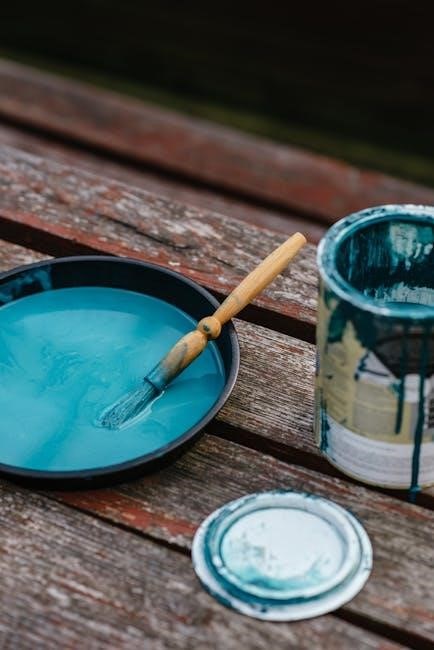
Rusty Metal Surfaces
When working with rusty metal surfaces‚ begin by scraping off loose rust and flaking material using a wire brush or power tool. This step ensures a stable surface for painting. For sound rusted metal‚ apply Rust-Oleum Rusty Metal Primer to prevent further corrosion and improve paint adhesion. If the surface is heavily rusted‚ consider applying a second coat of primer for added protection. Allow the primer to dry completely before proceeding. Avoid painting in direct sunlight or windy conditions‚ as this can lead to uneven results. Lightly sand the primed surface to ensure a smooth finish before applying the final paint. Always follow Rust-Oleum’s recommendations for drying times between coats to achieve the best results. Proper preparation of rusty metal surfaces is crucial for a durable and long-lasting finish.
Non-Metal Surfaces
For non-metal surfaces‚ such as wood or fiberglass‚ proper preparation is key to ensuring a strong bond with Rust-Oleum Farm and Implement Paint. Start by cleaning the surface thoroughly to remove dirt‚ grease‚ or other contaminants. Lightly sand the area to create a rough texture‚ which helps the paint adhere better. If painting fiberglass‚ apply a suitable fiberglass primer first‚ such as Rust-Oleum’s specialized primers‚ to ensure compatibility and durability. For wood‚ ensure it is dry and free of splinters before painting. Apply the paint in thin‚ even coats‚ allowing each coat to dry completely according to the manufacturer’s instructions. Avoid painting in direct sunlight or windy conditions‚ as this can affect the finish. By following these steps‚ you can achieve a professional-looking‚ long-lasting result on non-metal surfaces.
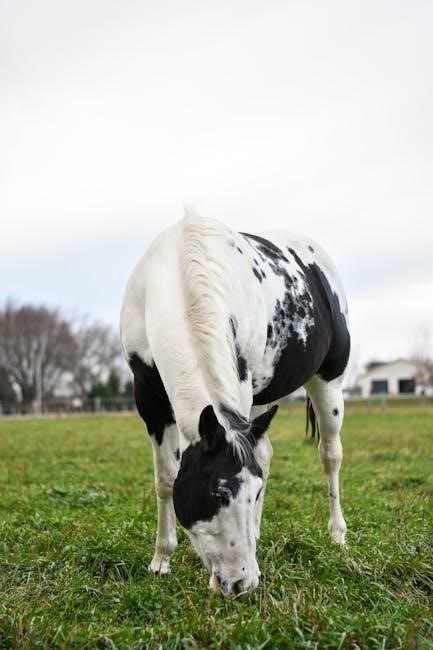
Priming
Priming is essential for creating a strong bond between the surface and paint‚ ensuring durability and rust prevention. Use Rust-Oleum primers designed for metal or fiberglass surfaces before painting.
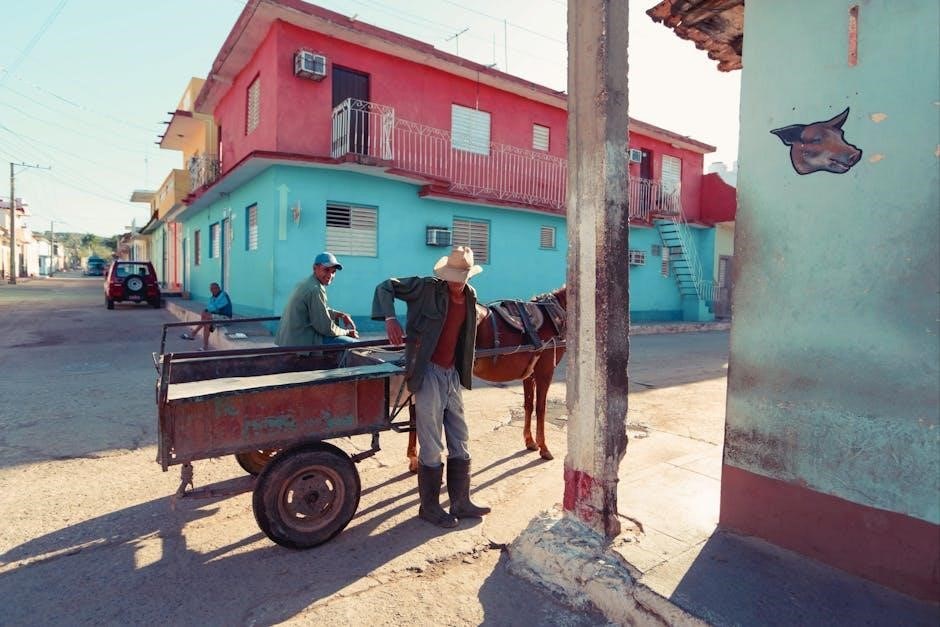
Importance of Priming
Priming is a critical step in the painting process‚ especially for farm equipment exposed to harsh conditions. It creates a strong bond between the surface and paint‚ reducing peeling and flaking. For steel surfaces‚ priming helps prevent rust from spreading‚ while on non-metal surfaces like fiberglass‚ it ensures better paint adhesion. Rust-Oleum primers are specifically designed to protect against corrosion and withstand heavy-duty use. Applying primer also enhances the paint’s durability‚ ensuring a long-lasting finish. Without proper priming‚ the paint may chip or fade prematurely‚ reducing the equipment’s lifespan. Always choose the right primer for your surface type to achieve optimal results and extend the life of your equipment.
Types of Primers
When using Rust-Oleum Farm and Implement Paint‚ selecting the right primer is essential for optimal results. Rust-Oleum offers a range of primers tailored to different surfaces and conditions. The Heavy Duty Primer is ideal for metal surfaces‚ providing a robust foundation and preventing rust. For surfaces with existing rust‚ the Rusty Metal Primer is recommended‚ as it adheres well to rusty surfaces and stops corrosion. Galvanized metal requires a specialized primer to ensure proper adhesion and prevent flaking. Additionally‚ epoxy primers are available for added durability and chemical resistance. Each primer is formulated to address specific challenges‚ ensuring a strong bond between the surface and paint. Always choose the primer that best matches your surface type to achieve a professional-grade finish and extend the lifespan of your equipment.
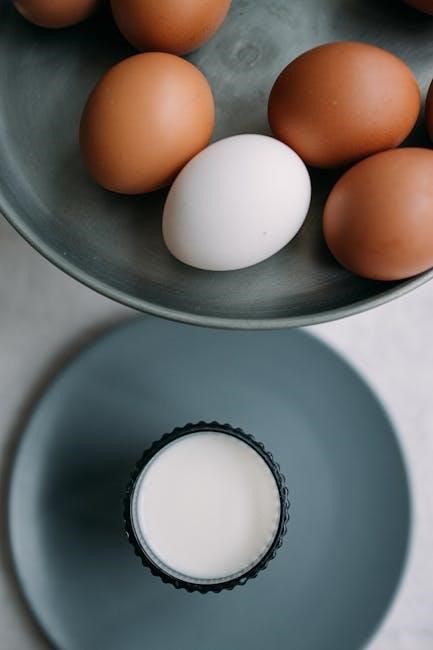
Primer Application Tips
Applying primer correctly is crucial for a successful paint job. Start by ensuring the surface is clean‚ dry‚ and free of grease or dust. For best results‚ apply primer in light‚ even coats‚ allowing each coat to dry completely before applying the next. Rust-Oleum recommends using a high-quality brush or spray gun for smooth coverage. When using aerosols‚ shake the can thoroughly and maintain a steady distance from the surface. Avoid applying primer in direct sunlight or windy conditions‚ as this can lead to uneven drying. For metal surfaces‚ scrape off loose rust first‚ then wire brush to create a better bond. Apply two or more light coats‚ waiting a few minutes between each. This ensures proper adhesion and a uniform base for painting. Proper primer application sets the foundation for a durable‚ long-lasting finish.
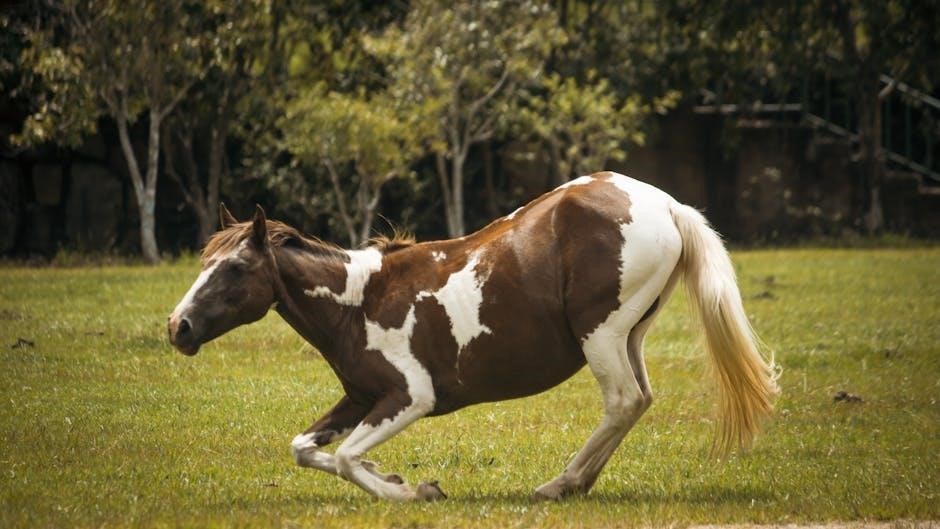
Painting Process
Follow a systematic approach for optimal results. Clean and prepare surfaces thoroughly‚ then prime if necessary. Apply paint in thin‚ even coats‚ allowing each to dry before adding the next layer. Use appropriate tools like brushes or spray guns‚ ensuring good ventilation. Avoid painting in direct sunlight or windy conditions to prevent uneven coverage. For aerosols‚ maintain a steady distance and shake cans well. Light coats spaced minutes apart ensure proper adhesion and a smooth finish. Allow the final coat to cure fully before exposing surfaces to weather or heavy use. This method ensures a durable‚ weather-resistant finish for farm equipment.
Materials Needed
To achieve a professional finish with Rust-Oleum Farm and Implement Paint‚ gather the following materials:
- Rust-Oleum Farm and Implement Paint in your desired color
- Rust-Oleum primer (for metal‚ wood‚ or fiberglass surfaces)
- Sandpaper (medium-grit for surface preparation‚ fine-grit for smoothing)
- Wire brush or power tool for removing rust and loose debris
- Paintbrushes or spray gun for application
- Paint thinner (if thinning is required for spray application)
- Drop cloths or tarps to protect surrounding areas
- Safety gear (gloves‚ goggles‚ mask)
- Well-ventilated workspace or respirator
- Optional: Clear coat for added protection (ensure compatibility)
Ensure all materials are compatible with your project’s surface type‚ whether metal‚ wood‚ or fiberglass. Proper preparation and application tools are key to a durable‚ weather-resistant finish.
Spray Application
For a smooth‚ even finish with Rust-Oleum Farm and Implement Paint‚ spray application is a popular method. Ensure the surface is clean‚ dry‚ and properly primed before spraying. Use a high-quality spray gun‚ such as a Harbor Freight spray gun‚ and maintain a consistent distance of 8-10 inches from the surface. Apply thin‚ even coats‚ allowing each layer to dry according to the product instructions before applying the next. Lightly thin the paint (10-20%) with Rust-Oleum thinner if needed for better flow. Avoid spraying in direct sunlight or windy conditions‚ as this can cause uneven coverage or dust contamination. Work in a well-ventilated area‚ and wear protective gear‚ including gloves‚ goggles‚ and a mask. For best results‚ apply in temperatures between 50°F and 90°F (10°C and 32°C). This method ensures a professional-looking finish on metal‚ wood‚ or fiberglass surfaces.
Brush Application
For brush application of Rust-Oleum Farm and Implement Paint‚ use a high-quality natural or synthetic bristle brush. Ensure the surface is clean‚ dry‚ and properly primed. Lightly thin the paint (10-20%) with Rust-Oleum thinner for better flow. Apply thin‚ even coats‚ working in small sections to maintain control. Avoid brushing too aggressively‚ as this can create unevenness. Work in temperatures between 50°F and 90°F (10°C and 32°C) and avoid direct sunlight. Allow each coat to dry according to the product instructions before applying the next. Brush application is ideal for detailed work‚ edges‚ and small areas. For best results‚ use smooth‚ steady strokes and avoid overloading the brush with paint. This method ensures a durable‚ weather-resistant finish on metal‚ wood‚ or fiberglass surfaces. Always follow safety precautions‚ including wearing gloves and working in a well-ventilated area. The result is a professional-looking coat with excellent adhesion and longevity.
Drying Times
Rust-Oleum Farm and Implement Paint typically dries to the touch within 15 minutes and is ready for a second coat in about 30 minutes under normal conditions. However‚ full cure time‚ where the paint reaches its maximum hardness and durability‚ can take up to 24 hours. Factors such as temperature‚ humidity‚ and thickness of application can influence drying times. Ensure the surface is clean‚ dry‚ and free of dust for optimal results. Avoid painting in direct sunlight or high humidity‚ as this can slow drying and affect the finish. Light coats applied at intervals of 15-30 minutes will help achieve a smooth‚ even finish. Always allow the recommended drying time between coats to ensure proper adhesion and durability. For exact drying times‚ refer to the product data sheet or manufacturer’s instructions. Proper drying ensures a long-lasting‚ weather-resistant finish.
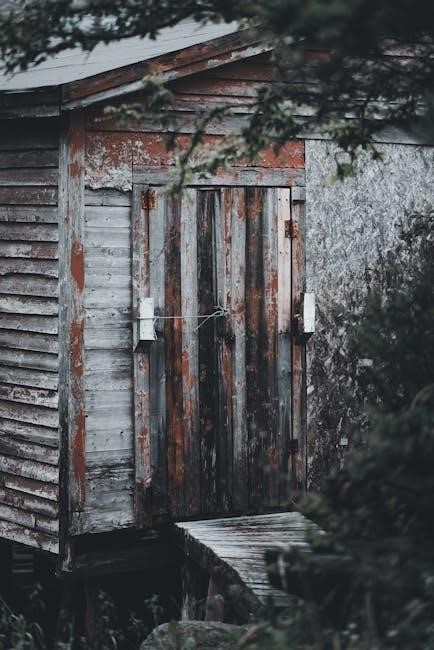
Special Considerations
Always avoid applying Rust-Oleum Farm and Implement Paint on surfaces exceeding 200°F or galvanized metal. Spraying in windy conditions can lead to dust contamination and uneven finishes. Ensure proper ventilation and avoid high humidity for optimal results. Clean surfaces thoroughly before application to prevent adhesion issues. Follow manufacturer guidelines for temperature ranges and surface preparation to achieve a durable‚ weather-resistant finish. Proper application conditions are critical for long-lasting performance. Avoid painting in direct sunlight or extreme weather conditions. Use protective gear and work in a well-ventilated area to ensure safety and best results.
Heat Surfaces
When working with Rust-Oleum Farm and Implement Paint‚ it’s crucial to avoid applying it to surfaces that may exceed 200°F (93°C) when in use. High heat can cause the paint to degrade‚ leading to peeling or cracking. This is especially important for equipment like engines or exhaust systems. Always test the surface temperature before painting to ensure it’s within the safe range. If the surface is too hot‚ allow it to cool down completely before applying the paint. Additionally‚ avoid painting in direct sunlight‚ as this can cause the surface to heat up unnecessarily. For surfaces exposed to heat‚ consider using a heat-resistant primer first to improve durability. Never skip this step‚ as it ensures better adhesion and long-term performance. Proper preparation and application are key to achieving a durable finish on heat-exposed surfaces.
Galvanized Metal
Rust-Oleum Farm and Implement Paint is not recommended for application directly on galvanized metal surfaces. The zinc coating on galvanized metal can interfere with paint adhesion‚ leading to peeling or flaking over time. For best results‚ ensure the surface is properly prepared. Lightly sand the galvanized metal to create a rough texture‚ which helps the primer adhere better. Apply a high-quality primer specifically designed for galvanized surfaces before painting. This step is crucial to ensure long-lasting durability and a professional finish. Always follow the manufacturer’s instructions for priming and painting galvanized metal to achieve optimal results. Proper preparation and the right primer will help the paint adhere effectively and withstand harsh environmental conditions. Avoid skipping this step‚ as it can significantly reduce the lifespan of the paint job on galvanized surfaces.
Windy Conditions
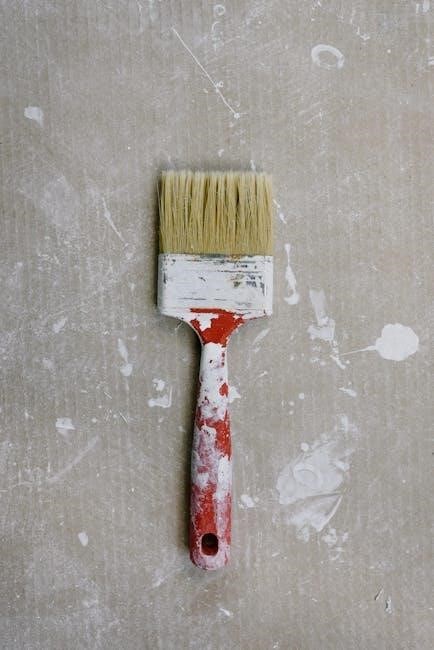
Painting in windy conditions can significantly affect the quality of your Rust-Oleum Farm and Implement Paint application. Wind can cause paint to drift‚ leading to uneven coverage and overspray on surrounding surfaces. To ensure a smooth‚ professional finish‚ avoid painting in windy or dusty environments. If you must paint outdoors‚ choose a sheltered area or wait for calmer conditions. Cover nearby surfaces‚ such as plants‚ vehicles‚ and furniture‚ with drop cloths or plastic sheeting to protect them from accidental overspray. Ideal painting conditions include low wind speeds and minimal dust. For best results‚ paint in a well-ventilated‚ controlled environment when possible. Always monitor weather conditions to avoid applying paint in unfavorable situations‚ as this can compromise the durability and appearance of the final finish.
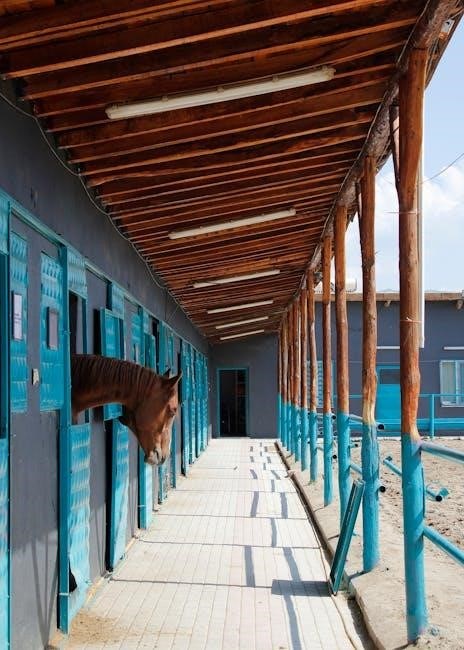
Common Mistakes to Avoid
Common mistakes include rushing surface preparation‚ incorrect paint thinning‚ and applying paint in direct sunlight or windy conditions. These errors can lead to uneven finishes and reduced durability.
Rushing Surface Prep
Rushing surface preparation is a common mistake that can lead to poor paint adhesion and reduced durability. Proper cleaning and removing loose rust‚ dirt‚ and old paint is essential for a strong bond between the surface and the primer or paint. Steel surfaces should be scraped and wire-brushed to remove rust and scale‚ while rusty metal requires a thorough cleaning with a power tool or sandpaper. Non-metal surfaces‚ such as fiberglass‚ need to be sanded and primed with a suitable fiberglass primer. Skipping these steps can result in peeling paint and premature corrosion. Always allow proper drying time between coats and avoid applying paint in direct sunlight or windy conditions. Remember‚ rushing surface prep can undo the entire painting process‚ so take the time to do it right for long-lasting results. This ensures the paint adheres well and withstands harsh environmental conditions. Proper preparation is key to achieving a professional finish.
Incorrect Thinning
Incorrectly thinning Rust-Oleum Farm and Implement Paint can lead to poor adhesion and a weak finish. Thinning too much reduces the paint’s durability and weather resistance. Use only the recommended thinner‚ and avoid over-thinning‚ as it can compromise the paint’s protective properties. For spray application‚ thinning by 10-15% is typically sufficient‚ depending on the spray gun’s nozzle size and airflow. Always follow the manufacturer’s guidelines for thinning ratios to ensure proper viscosity. Adding too much thinner can result in a streaked‚ uneven finish. For brush application‚ minimal thinning is usually needed‚ but ensure the paint flows smoothly off the brush. Proper thinning ensures the paint adheres well and provides a durable‚ rust-resistant coating. Avoid using household solvents or improper thinners‚ as they may damage the paint’s formulation. Proper preparation and application techniques are crucial for achieving a professional-looking finish that lasts. Always test the paint on a small area first to ensure the right consistency.
Using Rust-Oleum Farm and Implement Paint is an effective way to protect and beautify your equipment. By following proper surface preparation‚ priming‚ and application techniques‚ you can achieve a durable‚ weather-resistant finish. Always avoid common mistakes like rushing surface prep or incorrect thinning‚ as these can compromise the paint’s performance. Remember to work in well-ventilated areas‚ avoid windy conditions‚ and test the paint on a small area first. With the right approach‚ your equipment will look great and withstand the challenges of outdoor use. For best results‚ adhere to the manufacturer’s instructions and take necessary safety precautions. Properly applied‚ Rust-Oleum Farm and Implement Paint will provide long-lasting protection and a professional-looking finish. Thank you for reading‚ and happy painting!